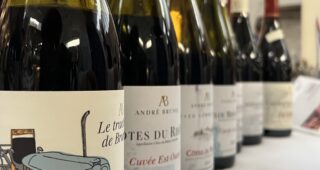For a wine lover, tasting newer wines is always an exciting proposition. It gives his/her palate a sense of novelty as well as a level of familiarity when encountering similar wines le prochain fois.
Likewise, a sense of déjà vu visited me as I tasted an array of interesting wines from the Czech Republic in New Delhi even as the Indian summer started its upsurge of notoriety. The tasting, conducted in the Czech Embassy premises, was introduced by Mr. Milan Tous, Head of Economic Section and saw attractive bottles putting the best foot forward to entice the audience into exploring them further. The ‘explorers’ didn’t disappoint either.
I had reason to feel at home since it was just the last year that the same sommelier Aleš Pokorný, had presented a bevy of Czech wines in his inimitable humoristic style that made people more curious to know about them. This year, humor duly in its place, Aleš went a step further to cover Czech wine regions in details, with the wines from these regions doing the tasting rounds simultaneously.
For those pressed for time, a quick snapshot of the event can be accessed through my FB post given below. For those with an eye for details, I would strongly recommend reading further.
https://www.facebook.com/pg/ravikjoe/photos/?tab=album&album_id=1285786324769744
One major hurdle in knowing Czech wines is the seemingly intimidating names on their labels. I attempted to simplify these names through my earlier post called 123 of Understanding Difficult Wine Labels published after the last year’s tasting. If you haven’t read it yet, give it a look to see how simple a Rulandske Modre can become to decipher.

(Pic: National Wine Centre, Czech Republic)

Coming to this year’s showcasing, a total of 10 wines and 3 spirits were presented in a guided- followed by a walk around tasting. Aleš presented the wines in tandem with highlighting the Czech wine regions and their quality system. I have tried to summarise these details in the following self explanatory and easily downloadable images.
Wines for tasting

Majority of Czech wine production is of white variety though rosés and reds are picking pace over the years. Ales highlighted that the Czech prefer to drink their wines young at higher levels of acidity rather than risking the loss of ‘balance’ due to the residual sugar becoming dominating. This aspect becomes more important on account of their quality system based on ‘must’ weight (higher ‘must’ weight implying more ripeness and hence more fermentable sugars) as also chaptalisation (a term used to denote adding sugar to ‘must’) which is allowed under the Czech wine law.

Sparkling wine Brut 2012
Producer: Chateau Winery Bzenec
A straw coloured crisp wine well suited as an aperitif.
Grüner Veltliner, Kabinet Wine 2015
Producer: Chateau Winery Bzenec
A delicate nose of white flowers and a little spice followed by a refreshing palate charecterised by high acidity and an off-dry style.
Pinot Blanc Selection of Grapes 2015
Producer: Chateau Winery Bzenec
A refined expression of the varietal with floral and tropical fruit aromas followed by a balanced, medium finish palate.
Chardonnay Late Harvest 2014
Producer: Templar Cellars Čejkovice
Medium gold colour with aromas of citrus and tree fruits. A refreshing medium-high acidity that could do better with a little mellowing- which would make this wine better enjoyable with its flavours fully opening up. Hence one can store this wine at least for a year before uncorking.
Tramin Late Harvest 2013
Producer: Templar Cellars Čejkovice
One of my favourites of the day with its expressive nose and a fleshy delectable palate. A spicy finish capped the wonderful experience.
Pinot Noir Rosé, Kabinet Wine 2013
Producer: Winery Krist Milotice
Another jewel at the tasting. With its appetising deep salmon pink colour and a ‘gourmet’ nose of red berries and candy, the wine stood up with it’s palate as well- replete with a good structure, dry disposition and a lengthy finish.
Müller Thurgau, Quality Wine
Producer: Templar Cellars Čejkovice
An entry level wine with a fruity nose, off dry palate and easy drinkability. Good for casual drinking particularly with spicy food.
Pinot Gris, Late Harvest 2011
Producer: Winery Krist Milotice
True to it’s varietal, this wine had a greyish straw colour and it had a nose of ripe peaches along with a yeasty accent. The acidity of the wine however seemed to be on the decline- which probably verified Ales’ statement about the Czech preferring to drink their wines young.
Tramin, Selection of Grapes 2011
Producer: Winery Krist Milotice
A wine with an expressive nose as expected. But for the residual sugar of 18 g/l (as informed by Ales) the acidity again seemed to be over the hill.
Blaufrankisch, Quality Wine
Producer: Templar Cellars Čejkovice
Apart from the Pinot Noir Rosé, this was the other red grape wine for the tasting. An entry level red, this was a pleasing wine with its luminiscent ruby colour, a fruity and nutty nose and medium tannins firming up towards the finish.
Spirits for tasting (From producer R Jelínek)
The spirits came from one of the most reputed distillers of the Czech Republic who particularly specialises in fruit brandies- particularly plum brandy which is called Slivovitz in Czech language. The products offered for the tasting brought a novelty to the palate. But I will reserve my tasting notes till I confirm them with another tasting!










